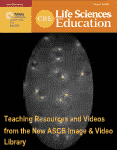Abstract
This article describes a simple and inexpensive hands-on simulation of protein folding suitable for use in large lecture classes. This activity uses a minimum of parts, tools, and skill to simulate some of the fundamental principles of protein folding. The major concepts targeted are that proteins begin as linear polypeptides and fold to three-dimensional structures, noncovalent interactions drive this folding process, and the final folded shape of a protein depends on its amino acid sequence. At the start of the activity, students are given pieces of insulated wire from which they each construct and fold their own polypeptide. This activity was evaluated in three ways. A random sample of student-generated polypeptides collected after the activity shows that most students were able to create an appropriate structure. After this activity, students (n = 154) completed an open-ended survey. Their responses showed that more than three-quarters of the students learned one or more of the core concepts being demonstrated. Finally, a follow-up survey was conducted seven weeks after the activity; responses to this survey (n = 63) showed that a similar fraction of students still retained these key concepts. This activity should be useful in large introductory-level college biology or biochemistry lectures.



